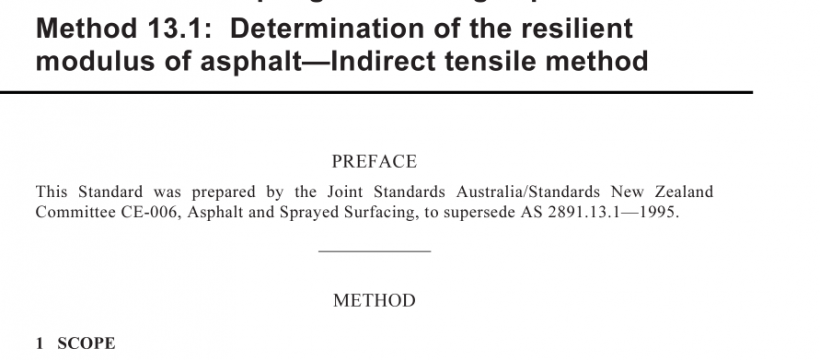AS NZS 2891.13.1:2013 pdf free download
AS NZS 2891.13.1:2013 pdf free download.Methods of sampling and testing asphalt
9.1 General
The following shall be reported:
(a) Asphalt mixture identification and relevant component details including nominal mix size, grading type, binder content and type.
(b) For laboratory compacted samples, report the method of sample preparation including number of cycles of the gyratory compactor.
(c) Air void content of specimens tested.
(d) Date and time of test.
(e) Date of specimen manufacture.
(f) If a core sample, the date of coring, location in the pavement, direction of traffic flow and date of placement of layer, if known.
(g) Description of test conditions as ‘standard reference test conditions used’ or ‘non-standard test conditions used’ together with variations to standard conditions.
(h) Other factors that may be considered to have influenced the results (e.g. reheating of asphalt, damage to cores, segregation, etc.).
(i) The number of this Standard, i.e, AS/NZS 2891.13.1.
9.2 Test results
The following shall be reported:
(a) Mean height of each specimen to the nearest 0.1 mm.
(b) Mean diameter of each specimen in to the nearest 0.1 mm.
(c) Core temperature of test to the nearest 0.5°C, rise time to the nearest 0.005 s and pulse repetition period [report as standard reference test conditions or, if standard reference test condition (Clause 6) are not used, the actual values].
(d) For the five post-conditioning pulses on each specimen—
(i) the average resilient modulus, in megapascals, to three significant figures; and
(ii) the coefficient of variation, in percentage units to two significant figures.
(e) Average resilient modulus of the asphalt specimens, in megapascals, to two significant figures.
(f) If the preconditioning did not achieve a resilient strain within the specified range, for each preconditioning pulse—
(i) the recovered strain, in microstrain; and
(ii) the resilient modulus, in megapascals.
(g) Reference to this method, i.e. AS/NZS 2891.13.1.
AS NZS 2891.13.1:2013 pdf free download
